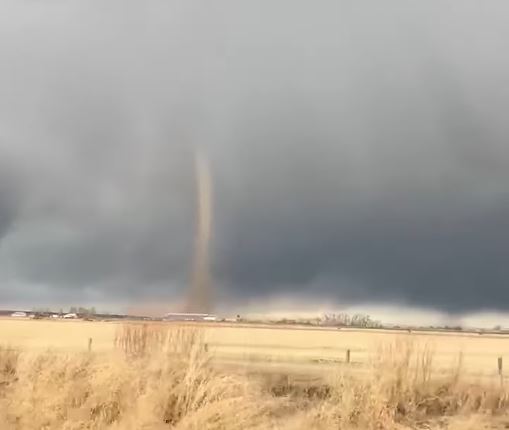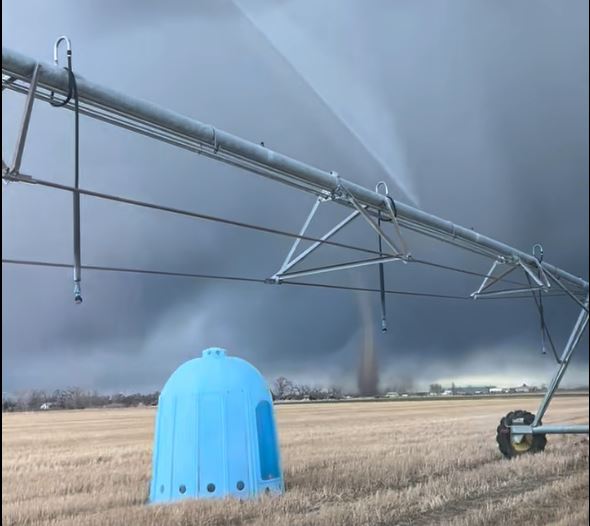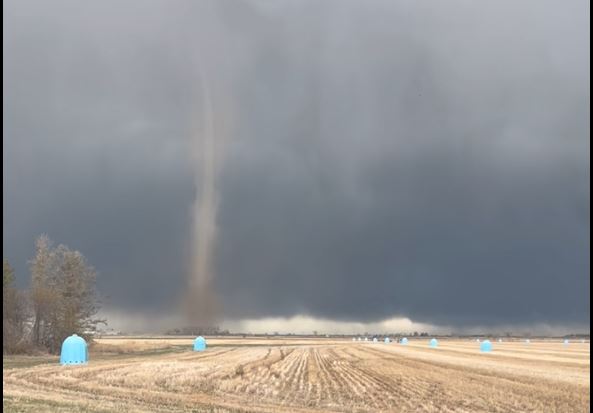It is only mid-April and already Canada has recorded the first tornado of the year.
Environment and Climate Change Canada confirm the twister was spotted at around 5:20 p.m. on Saturday, April 12, 2025, about 10 km north of Rolling Hills which is a farming community of 270 people located about a two hour drive southeast of Calgary.
Darby Lester told Global News that she was working in a field near her home when she saw something unusual and pulled out her phone.
“My husband was doing some field work and I was moving the pivot (irrigation equipment) out of his way and there were some dark clouds to the north, but nothing that was really cause for concern — and the next thing I knew I looked up at the sky and there was a tornado in April.”
Story continues below advertisement
Lester said what initially caught her eye was the swirling dust.
“I would say it was a relatively small tornado — it wasn’t very wide — and there was dust all around the bottom of it,” said Lester.
“Then when I saw what was causing the dust, that’s when I realized there was actually a funnel that had come all the way down from the clouds.”
Lester estimates she watched the twister for about five minutes before it finally dissipated.

Environment Canada has confirmed Canada’s first tornado of the year was spotted on Saturday near Rolling Hills, Alberta, about 230 km east of Calgary.
Courtesy: Darby Lester
Unlike the dozens of devastating supercell tornadoes that have struck the U.S. in recent weeks, Environment Canada said the tornado Lester saw was a landspout tornado — which is a much weaker type of tornado.

Get daily National news
Get the day’s top news, political, economic, and current affairs headlines, delivered to your inbox once a day.
“A landspout tornado develops when we have a weather front rolling through and we have converging winds — and so that causes rotation starting at the ground that moves up toward the cloud — and eventually the updraft of the cloud captures that landspout tornado and connects it from ground to cloud,” explained Global Calgary Meterorologist Tiffany Lizée.
Story continues below advertisement
A supercell tornado, on the other hand, begins at the cloud and makes its way down to the surface.
“Supercell tornadoes are often much stronger, cause a lot more damage and can be quite devastating,” said Lizée. “A landspout tornado is often much weaker — usually an EF0 or an EF1. They can still cause damage, but they don’t quite have the same amount of strength that a supercell tornado has.”
Landspout tornadoes are the most common type of tornado in Alberta, added Lizée. But even though they’re not as strong as supercell tornadoes, she said they should still be taken seriously and anyone who sees one should seek shelter.

Environment Canada has given the tornado a preliminary rating of EF0, which is the weakest kind of tornado, but it can still have wind speeds between 90 and 130 km/h.
Courtesy: Bantry Seed Farms
A preliminary report from Environment Canada has given the tornado a rating of EF0, which is the weakest level of tornado on the scale.
Story continues below advertisement
But it warns they can still have wind speeds of between 90 and 130 km/h, enough to “topple trees, damage roofs, or toss debris a short distance.”
Environment Canada has given the tornado a rating of EF0 which is the weakest kind of tornado on the Enhanced Fujita Scale.
Environment Canada

Courtesy: Bantry Seed Farms
Environment Canada is asking anyone who saw the tornado or has video or photos of it to please contact them.
Story continues below advertisement
Photos of the tornado have been widely posted on social media by Lester and others who saw it.
There are no reports of any damage, but Environment Canada is asking anyone who may have witnessed it, or has photos or video to please contact them by calling 1-800-239-0484, by email at storm@ec.gc.ca, or by using the hashtag #abstorm in social media posts.
© 2025 Global News, a division of Corus Entertainment Inc.






